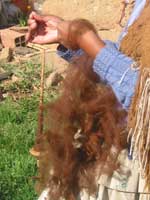The aguayo is a multicolor squared weave, it is characteristic mainly of the Andean region of Bolivia, this weaves are used to carry babies and small children in the back, to seat down, to put food or other type of products.
Artisan process :
All the process of elaboration, from the sheared of the wool to the weave is hand made.

 After shearing the wool the work of selection and washing comes. When the wool is clean of impurities, you proceed to the spinning process in a wooden cylindrical instrument called “rueca”.
After shearing the wool the work of selection and washing comes. When the wool is clean of impurities, you proceed to the spinning process in a wooden cylindrical instrument called “rueca”.
When the wool passes various times through the rueca, you get a finer thread.
The next step is to dye, in this case the wool can be dyed either with natural colors, using plants or small insects that are found in the region, or with artificial colors.
Once the wool is ready its put on the weaving looms, here is where the
colors are organized and arranged in function of the design that is wanted.

There are three types of weaves:
- The vertical weave, where the threads extend vertically to the floor, it is the most expanded technique, but not the only one.
- The weave to the waist, where one part of the weave is brought closer to an immovable thing (beam, tree.) and the other tied to the waist of the weaver, who controls the tension of the weave by inclining towards ahead.

- Finally, the horizontal, oblique or rustic weave, it is the easiest weave where the threads should extend over a bar horizontally to the floor.
The design and the colors of each aguayo depend of the group that elaborates them, each one has its own characteristics. In general the aguayo figures tell stories of the community and show symbols of the culture according to the regions.


